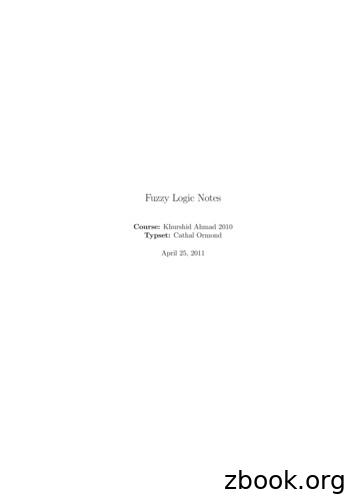Logic I And II - Texas Education Agency
Logic I and IIPEIMS Code: N1290100, N1290101Abbreviation: LOGIC1, LOGIC2Grade Level(s): 9–10Award of Credit: 0.5 each courseApproved Innovative Course Districts must have local board approval to implement innovative courses. In accordance with Texas Administrative Code (TAC) §74.27, school districts mustprovide instruction in all essential knowledge and skills identified in this innovativecourse. Innovative courses may only satisfy elective credit toward graduation requirements. Please refer to TAC §74.13 for guidance on endorsements.Course Description:Logic I provides course content in informal logic which includes intensive experience with logicalfallacies and an emphasis on inductive reasoning, strong versus weak and fallaciousarguments, and probability. Informal logic concentrates on evaluating the content of anargument and deals almost entirely with “ordinary language arguments” in the interchange ofideas between people.Logic II is a course in formal logic, or the logic that pertains to pure reasoning in the abstract –deductive reasoning, valid or invalid arguments, and certainty (given the premise). In Logic II,students fully engage in the world of syllogism where focus is placed on understanding the formof an argument, and arguments can be analyzed using symbols.Essential Knowledge and Skills:Logic I(a)General Requirements. This course is recommended for students in grades 9 and10. Students shall be awarded one-half credit for successful completion of thiscourse.(b)Introduction.(1)Logic I complements thinking, writing, and speaking skill-building that is atthe center of language arts and social studies curricula. Logic alsocomplements Latin knowledge; it aims at precision of language and Latin is avery precise language, and many of the names of logical fallacies arederived from Latin.(2)Logic I provides course content in informal logic which includes experiencewith logical fallacies and an emphasis on inductive reasoning, strong versusApproved for use beginning: 2015-2016Approved for use beginning: 2013-2014Page 1
Logic I and IIweak arguments, and probability. Informal logic concentrates on evaluatingthe content of an argument and deals almost entirely with “ordinary languagearguments” in the interchange of ideas between people.(c)Knowledge and Skills.(1)(2)(3)(4)(5)Logic. The student understands the historical development of logic and thedifferences between informal and formal logic. The student is expected to:(A)define logic and argument; and(B)describe the differences between informal and formal logic.Ad Fontem Arguments. The student uses knowledge about an audience toemploy ad fontem arguments that produce desired reactions. The student isexpected to:(A)identify and analyze fallacious arguments including ad hominemabusive, ad hominem circumstantial, tu quoque, and genetic fallacy;(B)analyze the purposes and power of using ad fontem arguments;and(C)create and apply ad fontem arguments in speech and in writing.Appeals to Emotion. The student uses knowledge about an audience toemploy an appeal that produces a desired reaction. The student is expectedto:(A)identify fallacious arguments including appeal to fear (argumentumad baculum), appeal to pity (argumentum ad misericordiam), mobappeal (argumentum ad populum), snob appeal, appeal toillegitimate authority (argumentum ad verecundiam), andchronological snobbery;(B)analyze the purposes and power of using appeals to emotion; and(C)create and apply appeals to emotion in speech in writing.Red Herrings. The student uses knowledge about an audience to employ redherrings that produces desired reactions. The student is expected to:(A)identify and analyze fallacious arguments including appeal toignorance, irrelevant goals or functions, irrelevant thesis, and strawman fallacy;(B)analyze the purposes and power of using red herrings; and(C)create and apply red herrings in speech and in writing.Fallacies of Pres
(2) Ad Fontem Arguments. The student uses knowledge about an audience to employ ad fontem arguments that produce desired reactions. The student is expected to: (A) identify and analyze fallacious arguments including ad hominem abusive, ad hominem circumstantial, tu quoque, and genetic fallacy;
Texts of Wow Rosh Hashana II 5780 - Congregation Shearith Israel, Atlanta Georgia Wow ׳ג ׳א:׳א תישארב (א) ׃ץרֶָֽאָּהָּ תאֵֵ֥וְּ םִימִַׁ֖שַָּה תאֵֵ֥ םיקִִ֑לֹאֱ ארָָּ֣ Îָּ תישִִׁ֖ארֵ Îְּ(ב) חַורְָּ֣ו ם
Dynamic Logic Dynamic Circuits will be introduced and their performance in terms of power, area, delay, energy and AT2 will be reviewed. We will review the following logic families: Domino logic P-E logic NORA logic 2-phase logic Multiple O/P domino logic Cascode logic
The University of Texas at Arlington Sequential Logic - Intro CSE 2340/2140 – Introduction to Digital Logic Dr. Gergely Záruba The Sequential Circuit Model x 1 Combinational z1 x n zm (a) y y Y Y Combinational logic logic x1 z1 x n z m Combinational logic with n inputs and m switching functions: Sequential logic with n inputs, m outputs, r .
categorical and hypothetical syllogism, and modal and inductive logic. It is also associated with the Stoics and their propositional logic, and their work on implication. Syllogistic logic and propositional logic led later to the development of predicate logic (or first order logic, i.e. the foundational logic for mathematics)
MOSFET Logic Revised: March 22, 2020 ECE2274 Pre-Lab for MOSFET logic LTspice NAND Logic Gate, NOR Logic Gate, and CMOS Inverter Include CRN # and schematics. 1. NMOS NMOSNAND Logic Gate Use Vdd 10Vdc. For the NMOS NAND LOGIC GATE shown below, use the 2N7000 MOSFET LTspice model that has a gate to source voltage Vgs threshold of 2V (Vto 2.0).File Size: 586KB
Digital Logic Fundamentals Unit 1 – Introduction to the Circuit Board 2 LOGIC STATES The output logic state (level) of a gate depends on the logic state of the input(s). There are two logic states: logic 1, or high, and logic 0, or low. The output of some gates can also be in a high-Z (high impedance) state, which is neither a high
Logic Cross-Reference First Revision Introduction This Logic Cross-Reference for Buyers, Distribution Specialists and others with an interest in Logic will assist in finding a device made by Texas Instruments that is identical or similar to many of our competitors' Logic products. The Logic Cross-Reference is divided into several sections.
2.2 Fuzzy Logic Fuzzy Logic is a form of multi-valued logic derived from fuzzy set theory to deal with reasoning that is approximate rather than precise. Fuzzy logic is not a vague logic system, but a system of logic for dealing with vague concepts. As in fuzzy set theory the set membership values can range (inclusively) between 0 and 1, in























